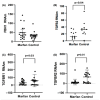Analysis of FBN1, TGFβ2, TGFβR1 and TGFβR2 mRNA as Key Molecular Mechanisms in the Damage of Aortic Aneurysm and Dissection in Marfan Syndrome
- PMID: 40243722
- PMCID: PMC11989073
- DOI: 10.3390/ijms26073067
Analysis of FBN1, TGFβ2, TGFβR1 and TGFβR2 mRNA as Key Molecular Mechanisms in the Damage of Aortic Aneurysm and Dissection in Marfan Syndrome
Abstract
Marfan syndrome (MFS) is an inherited connective tissue disorder, with aortic root aneurysm and/or dissection being the most severe and life-threatening complication. These conditions have been linked to pathogenic variants in the FBN1 gene and dysregulated TGFβ signaling. Our objective was to evaluate the mRNA expression of FBN1, TGFBR1, TGFBR2, and TGFB2 in aortic tissue from MFS patients undergoing surgery for aortic dilation. This prospective study (2014-2023) included 20 MFS patients diagnosed according to the 2010 Ghent criteria, who underwent surgery for aneurysm or dissection based on Heart Team recommendations, along with 20 non-MFS controls. RNA was extracted, and mRNA levels were quantified using RT-qPCR. Patients with dissection showed significantly higher FBN1 mRNA levels [79 (48.1-110.1)] compared to controls [37.2 (25.1-79)] (p = 0.03). Conversely, TGFB2 expression was significantly lower in MFS patients [12.17 (6.54-24.70)] than in controls [44.29 (25.85-85.36)] (p = 0.029). A positive correlation was observed between higher FBN1 expression and a larger sinotubular junction diameter (r = 0.42, p = 0.07), while increased FBN1 expression was particularly evident in MFS patients with dissection. Additionally, TGFB2 expression showed an inverse correlation with ascending aortic diameter (r = 0.53, p = 0.01). In aortic tissue, we found decreased TGFB2 and receptor levels alongside increased FBN1 mRNA levels. These molecular alterations may reflect compensatory mechanisms in response to tissue damage caused by mechanical stress, leading to dysregulation of physiological signaling pathways and ultimately contributing to aortic dilation in MFS.
Keywords: FBN1; Marfan syndrome; TGFβ2; TGFβR1; TGFβR2; aortic dissection.
Conflict of interest statement
The authors declare no conflicts of interest.
Figures


Similar articles
-
Relationship between fibrillin-1 genotype and severity of cardiovascular involvement in Marfan syndrome.Heart. 2017 Nov;103(22):1795-1799. doi: 10.1136/heartjnl-2016-310631. Epub 2017 May 3. Heart. 2017. PMID: 28468757
-
XOR-Derived ROS in Tie2-Lineage Cells Including Endothelial Cells Promotes Aortic Aneurysm Progression in Marfan Syndrome.Arterioscler Thromb Vasc Biol. 2025 Mar;45(3):e63-e77. doi: 10.1161/ATVBAHA.124.321527. Epub 2025 Jan 30. Arterioscler Thromb Vasc Biol. 2025. PMID: 39882602
-
miR-29b participates in early aneurysm development in Marfan syndrome.Circ Res. 2012 Jan 20;110(2):312-24. doi: 10.1161/CIRCRESAHA.111.253740. Epub 2011 Nov 23. Circ Res. 2012. PMID: 22116819
-
Genetic basis of hereditary thoracic aortic aneurysms and dissections.J Cardiol. 2019 Aug;74(2):136-143. doi: 10.1016/j.jjcc.2019.03.014. Epub 2019 Apr 15. J Cardiol. 2019. PMID: 31000321 Review.
-
Cardiovascular characteristics in Marfan syndrome and their relation to the genotype.Verh K Acad Geneeskd Belg. 2009;71(6):335-71. Verh K Acad Geneeskd Belg. 2009. PMID: 20232788 Review.
Cited by
-
Elevated Expression of TGFB1 in PBMCs Is Associated with Intracranial Aneurysm Formation, but TGFB3 Expression Implicated Rupture.Biomedicines. 2025 May 22;13(6):1273. doi: 10.3390/biomedicines13061273. Biomedicines. 2025. PMID: 40563991 Free PMC article.
References
-
- Faivre L.C.B.G., Collod-Beroud G., Loeys B.L., Child A., Binquet C., Gautier E., Callewaert B., Arbustini E., Mayer K., Arslan-Kirchner M., et al. Effect of Mutation Type and Location on Clinical Outcome in 1,013 Probands with Marfan Syndrome or Related Phenotypes and FBN1 Mutations: An International Study. Am. J. Hum. Genet. 2007;81:454–466. doi: 10.1086/520125. - DOI - PMC - PubMed
-
- Loeys B.L., Chen J., Neptune E.R., Judge D.P., Podowski M., Holm T., Meyers J., Leitch C.C., Katsanis N., Sharifi N., et al. A syndrome of altered cardiovascular, craniofacial, neurocognitive and skeletal development caused by mutations in TGFBR1 or TGFBR2. Nat. Genet. 2005;37:275–281. doi: 10.1038/ng1511. - DOI - PubMed
MeSH terms
Substances
LinkOut - more resources
Full Text Sources
Medical

